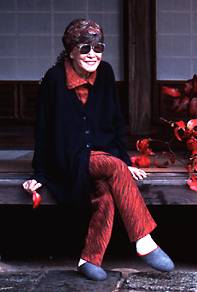We feel that the time she spent among us may hold a vital message
for us now living in the 21st century.
Masako Shirasu was a noted essayist and
the first woman to perform in traditional Japanese Noh plays. She often
visited small villages around Kyoto and Nara. In her writings these
various places became one, which she referred to as the “Secret
Village”, a place where a particularly Japanese style of life continues
to exist. She loved art and made it an essential part of her daily surroundings
and “The World of Masako Shirasu” features art objects that
she collected throughout her life.
As autumn falls on the Shigaraki Mountains,
visitors might leave this exhibition feeling as if they just had a heartfelt
talk with Ms Shirasu, a dialogue that gives one the courage to live
each day to its fullest and the insight to truly know the place where
one stands for the first time. This is a memorial exhibition of a memorable
woman and it is our hope that visitors will carry the memories of what
they have seen and felt home with them.
